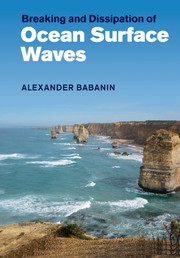Book contents
- Frontmatter
- Contents
- Preface
- 1 Introduction
- 2 Definitions for wave breaking
- 3 Detection and measurement of wave breaking
- 4 Fully nonlinear analytical theories for surface waves and numerical simulations of wave breaking
- 5 Wave-breaking probability
- 6 Wave-breaking severity
- 7 Energy dissipation across the wave spectrum
- 8 Non-dissipative effects of breaking on the wave field
- 9 Role of wave breaking in the air–sea interaction
- 10 Conclusions. What else do we need to know about wave breaking?
- References
- Index
10 - Conclusions. What else do we need to know about wave breaking?
Published online by Cambridge University Press: 25 October 2011
- Frontmatter
- Contents
- Preface
- 1 Introduction
- 2 Definitions for wave breaking
- 3 Detection and measurement of wave breaking
- 4 Fully nonlinear analytical theories for surface waves and numerical simulations of wave breaking
- 5 Wave-breaking probability
- 6 Wave-breaking severity
- 7 Energy dissipation across the wave spectrum
- 8 Non-dissipative effects of breaking on the wave field
- 9 Role of wave breaking in the air–sea interaction
- 10 Conclusions. What else do we need to know about wave breaking?
- References
- Index
Summary
Wave breaking represents one of the most interesting and most challenging problems for both fluid mechanics and physical oceanography. It is an intermittent random process, very fast by comparison with other processes in the wave system. The distribution of wave breaking on the water surface is not continuous, but its role in maintaining the energy balance within the continuous wind–wave field is critical.
The challenges thus outlined make understanding of such wave breaking and even an ability to describe its onset very difficult, and as a result knowledge of the physics of the breaking, and even practical parameterisations of the phenonemon have been hindered for decades. Recently, knowledge of the breaking phenomenon has significantly advanced, and this book is an attempt to summarise the facts into a consistent, even if still incomplete, picture of the phenomenon.
If this picture were to be formulated into a few paragraphs of these conclusions, we would like to say the following. The waves break because the water surface reaches some limiting steepness. Apparently, the fluid interface has to have a limit beyond which it will collapse. In the system of nonlinear water-surface waves subject to a variety of external forcings and internal instabilities, there are a number of physical processes which can lead to such a steepness. They are the modulational instability, linear (dispersive and directional) and nonlinear (amplitude-dispersion) focusing, modulation of steepness of shorter waves by longer waves, direct forcing by the wind (if very strong) or by the current, and wave-bottom interactions, among others.
- Type
- Chapter
- Information
- Breaking and Dissipation of Ocean Surface Waves , pp. 405 - 425Publisher: Cambridge University PressPrint publication year: 2011



